
by Jennifer Hart Yim | Nov 4, 2014 | Blog, Leadership, Marketing, Social Media, Strategy
Within five years social media literacy will be the single greatest factor distinguishing top performing procurement leaders from the rest.
Now don’t get me wrong – that’s not to diminish the importance of superior financial skills, sourcing, and/or change or people management abilities, but simply to say that social media will add a new dimension to these existing critical competencies.
For Roland Deiser and Sylvain Newton, authors of McKinsey Quarterly ‘The six social media skills every leader needs’, social media has created a dilemma for executives: “while the potential of social media is immense, the inherent risks create uncertainty and unease.”
For those schooled in 20th century management theories, social media’s unscripted approach to conversations, horizontal collaboration and fragmented power structures, is undoubtedly unsettling.
But the transformative power of social media is too big, too loud, and simply too pervasive to miss.
Today, Procurement Leaders are expected to ‘do everything.’ Is social media just ANOTHER thing to add to their To-Do list?
Yes and no – but that doesn’t mean it has to be a thorn in your side. Instead, why not utilize the seemingly transformational power that social media represents? Not only will it allow you to manage change more effectively and maintain costs, but it will also negate the risk of unruly online behavior.
If you’re hoping social media is really just an issue for the Chief Marketing Officer (or perhaps even just your teenage daughter and son), this next statement is going to hurt: Every leader – regardless of industry or profession – needs to be social media savvy, and the expectations for CPOs to be masterful (not just literate) are ever greater. Here’s why:
1. Procurement needs to create 360 degree visibility
Social media visibility will help position yourself as a connected thought-leader in the eyes of not just your team, but your Board and suppliers too.
You’re in a unique position – as the facilitator of connectivity you should rightly take the lead when it comes to all-things social. Suppliers can benefit from simple initiatives like creating private groups that can be used as discussion areas.
2. Procurement needs to be a Customer of Choice (and stay ahead of sales during negotiations)
Your marketing team has probably been using social media to connect with customers for years. Although the use of social media to connect with suppliers is still in its infancy (although eMarket places are rapidly growing), be assured that sales executives are already scanning social media to understand your industry (and you as a customer) better.
3. Procurement needs to mitigate the risk
So here comes the scary part – while the benefits of social media are real, so too are the risks when it comes to issues of commercial in confidence and defamation.
Procurement (and your suppliers) deal with highly sensitive issues on a daily basis. CPOS must understand social media in order to develop and manage an operational social media policy that stimulates collaboration, but adequately mitigates risk. And don’t even think about a social media blackout…your employees, your suppliers, your customers are online so it pays to stay one step ahead.
4. Procurement needs to upskill… or die
There has never been a more pressing time to engage, retain and upskill existing procurement talent.
The labor market is tightening, bringing with it new risks.
Luckily social media breeds collaboration, making approaches such as peer-to-peer learning a viable (and cost-effective) option to procurement professionals looking to develop.
What’s more, by its very nature online learning is highly accessible and available across a range of devices and form-factors. At the time of writing, all of Procurious’ training modules are free to members. So go and get them while they’re hot!
If the thought of social media literacy has you thinking fondly of the ‘good old days’ of cost-downs and low hanging fruit, there is good news: like any skill, social media can be taught so start by mastering the basics, start with understanding:
- The different social media platforms – start with: Procurious; LinkedIn; Facebook; YouTube; Twitter; and Instagram. Think about their intended purpose, how they differ; their reach and their impact
- Basic Twitter functionality
- Simple social media terminology – start with: hashtag; retweet; like; follow; mention; blog; podcast; RSS feed. I recommend checking out Buzz Billboard’s Social Media Glossary here: https://www.buzzbinpadillacrt.com/social-media-glossary/
Now if all this sounds time consuming, well it can be…but it doesn’t have to.
Much like exercise, learning to juggle or learning the guitar, the key is usually to start small and be consistent. At Procurious, we recommend ‘The Daily Habit’ – it takes 15 minutes and can be done as you sip your morning double-shot skim latte:
Scan the Headlines – 5 min
Check the latest news and blogs, keeping your eyes peeled for “water cooler moments”, mentions of your suppliers or competitors in the headlines and be ready to dazzle colleagues and stakeholders with the factoids and market intelligence you’ve found.
Share – 4 min
What did you find that was interesting? An article? A comment? A quote? Well, post it to social media and get people reading and talking.
As procurement people we in fact have access to great, shareable content – in fact many of the best stories come out of buyer/supplier relationships: weird categories sourced; inspiring social procurement stories; and photos from Supplier Awards days.
Ask (or be) an expert – 4 min
One of the busiest parts Procurious is our Discussions area. Most social media platforms will have similar groups or boards where you can throw out a question to the network…..you’ll be impressed by the willingness of people to share their learnings….or at the very least, realize you’re not alone in your challenges!
Grow your network – 2 min
To be the world’s best at procurement, you need to be the most connected. Be referred. Invite people to join your social media networks – on Procurious, you can narrow this down by geography, industry and category which means you can connect with like-minded peers from across the globe. Aim to connect with 10 new people a day across your networks.
Change management, financial literacy, sourcing, vendor and people management will always be core to procurement. Social media, however, allows you to approach these tasks with far greater reach, influence and a superior market intelligence.
Lisa Malone is the General Manager – Procurious – the world’s first online business network for procurement and supply chain professionals.
If you’d like to learn more about how to grow your social media literacy, connect with her on Procurious at (it’s free to join and participate) or follow on Twitter @lisajoymalone.

by Jennifer Hart Yim | Nov 4, 2014 | Blog, Leadership, Marketing, Social Media, Strategy
Within five years social media literacy will be the single greatest factor distinguishing top performing procurement leaders from the rest.
Now don’t get me wrong – that’s not to diminish the importance of superior financial skills, sourcing, and/or change or people management abilities, but simply to say that social media will add a new dimension to these existing critical competencies.
For Roland Deiser and Sylvain Newton, authors of McKinsey Quarterly ‘The six social media skills every leader needs’, social media has created a dilemma for executives: “while the potential of social media is immense, the inherent risks create uncertainty and unease.”
For those schooled in 20th century management theories, social media’s unscripted approach to conversations, horizontal collaboration and fragmented power structures, is undoubtedly unsettling.
But the transformative power of social media is too big, too loud, and simply too pervasive to miss.
Today, Procurement Leaders are expected to ‘do everything.’ Is social media just ANOTHER thing to add to their To-Do list?
Yes and no – but that doesn’t mean it has to be a thorn in your side. Instead, why not utilize the seemingly transformational power that social media represents? Not only will it allow you to manage change more effectively and maintain costs, but it will also negate the risk of unruly online behavior.
If you’re hoping social media is really just an issue for the Chief Marketing Officer (or perhaps even just your teenage daughter and son), this next statement is going to hurt: Every leader – regardless of industry or profession – needs to be social media savvy, and the expectations for CPOs to be masterful (not just literate) are ever greater. Here’s why:
1. Procurement needs to create 360 degree visibility
Social media visibility will help position yourself as a connected thought-leader in the eyes of not just your team, but your Board and suppliers too.
You’re in a unique position – as the facilitator of connectivity you should rightly take the lead when it comes to all-things social. Suppliers can benefit from simple initiatives like creating private groups that can be used as discussion areas.
2. Procurement needs to be a Customer of Choice (and stay ahead of sales during negotiations)
Your marketing team has probably been using social media to connect with customers for years. Although the use of social media to connect with suppliers is still in its infancy (although eMarket places are rapidly growing), be assured that sales executives are already scanning social media to understand your industry (and you as a customer) better.
3. Procurement needs to mitigate the risk
So here comes the scary part – while the benefits of social media are real, so too are the risks when it comes to issues of commercial in confidence and defamation.
Procurement (and your suppliers) deal with highly sensitive issues on a daily basis. CPOS must understand social media in order to develop and manage an operational social media policy that stimulates collaboration, but adequately mitigates risk. And don’t even think about a social media blackout…your employees, your suppliers, your customers are online so it pays to stay one step ahead.
4. Procurement needs to upskill… or die
There has never been a more pressing time to engage, retain and upskill existing procurement talent.
The labor market is tightening, bringing with it new risks.
Luckily social media breeds collaboration, making approaches such as peer-to-peer learning a viable (and cost-effective) option to procurement professionals looking to develop.
What’s more, by its very nature online learning is highly accessible and available across a range of devices and form-factors. At the time of writing, all of Procurious’ training modules are free to members. So go and get them while they’re hot!
If the thought of social media literacy has you thinking fondly of the ‘good old days’ of cost-downs and low hanging fruit, there is good news: like any skill, social media can be taught so start by mastering the basics, start with understanding:
- The different social media platforms – start with: Procurious; LinkedIn; Facebook; YouTube; Twitter; and Instagram. Think about their intended purpose, how they differ; their reach and their impact
- Basic Twitter functionality
- Simple social media terminology – start with: hashtag; retweet; like; follow; mention; blog; podcast; RSS feed. I recommend checking out Buzz Billboard’s Social Media Glossary here: https://www.buzzbinpadillacrt.com/social-media-glossary/
Now if all this sounds time consuming, well it can be…but it doesn’t have to.
Much like exercise, learning to juggle or learning the guitar, the key is usually to start small and be consistent. At Procurious, we recommend ‘The Daily Habit’ – it takes 15 minutes and can be done as you sip your morning double-shot skim latte:
Scan the Headlines – 5 min
Check the latest news and blogs, keeping your eyes peeled for “water cooler moments”, mentions of your suppliers or competitors in the headlines and be ready to dazzle colleagues and stakeholders with the factoids and market intelligence you’ve found.
Share – 4 min
What did you find that was interesting? An article? A comment? A quote? Well, post it to social media and get people reading and talking.
As procurement people we in fact have access to great, shareable content – in fact many of the best stories come out of buyer/supplier relationships: weird categories sourced; inspiring social procurement stories; and photos from Supplier Awards days.
Ask (or be) an expert – 4 min
One of the busiest parts Procurious is our Discussions area. Most social media platforms will have similar groups or boards where you can throw out a question to the network…..you’ll be impressed by the willingness of people to share their learnings….or at the very least, realize you’re not alone in your challenges!
Grow your network – 2 min
To be the world’s best at procurement, you need to be the most connected. Be referred. Invite people to join your social media networks – on Procurious, you can narrow this down by geography, industry and category which means you can connect with like-minded peers from across the globe. Aim to connect with 10 new people a day across your networks.
Change management, financial literacy, sourcing, vendor and people management will always be core to procurement. Social media, however, allows you to approach these tasks with far greater reach, influence and a superior market intelligence.
Lisa Malone is the General Manager – Procurious – the world’s first online business network for procurement and supply chain professionals.
If you’d like to learn more about how to grow your social media literacy, connect with her on Procurious at (it’s free to join and participate) or follow on Twitter @lisajoymalone.
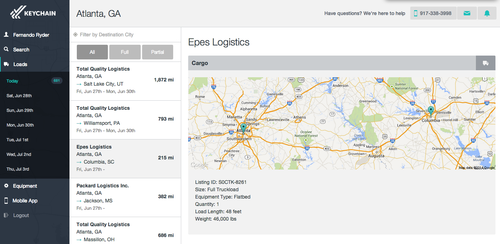
by Jennifer Hart Yim | Aug 7, 2014 | Blog, Marketing, Social Media, Supply Chain, Transportation & Trucking
This guest post is written by Keychain Logistics. Keychain Logistics is a leading transportation provider enabling businesses to directly engage carriers, track shipments, and monitor its logistics needs online.

It’s 2012. Platforms like Uber, Airbnb, and Homejoy are growing rapidly. New customers are signing up via search, paid referrals, and social media. Marketing teams at each are delicately balancing the supply and demand of their output with a spread of calculations that, if not projected carefully, may lead to service outages and upset customers.
Now what’s going on here, and what does this have to do with logistics?
The companies above, alongside many others eating the world today with software, are all marketplaces.
Speaking in online terms, a marketplace is where buyers and sellers of a particular product or service can collaborate in a streamlined process to achieve what they want from the other side.
In exchange for facilitating relationships, thus saving time and resources for the entities wanting to connect, marketplaces may charge subscription fees, transaction commissions, or depend simply on high traffic volume to sell other assets like media space or proprietary content.
But facilitating relationships is only a necessary component, and not a sufficient one, to the success of a marketplace. This is because some buyers and sellers feel that the benefit of a marketplace has been fully realized upon their connection, and thus don’t stick around for the platform to send a bill.
What marketplaces must do to maintain engaged users, then, is create experiences inside the application that remove the incentive to circumvent it. And this is a tough challenge to solve.
One great example of this is Odesk.com, a marketplace connecting freelancers with employers who have projects to outsource. In exchange for this service, Odesk charges a 10% fee to employers per transaction. While this may sound steep, Odesk meets this ask with a suite of free management tools such as random monitor screenshots that let employers track the productivity of an outsourced team member without worrying about being overbilled on hours.
For freelancers, Odesk requires employers to place valid credit cards on file pre-hire, protecting them from employers who might otherwise attempt to avoid a payment. Tools like this make the Odesk platform (and its fees) worth every penny, thus creating a winning marketplace that helps both sides get what they deserve.
That said, let’s get back to logistics and how Keychain Logistics fits into this marketplace, value-adding, supply and demand spectrum.
The transportation industry is one of the largest, oldest conglomerates on the planet, with millions of drivers and thousands of shippers and brokerages in the US alone. The industry is also a fragmented one, with the biggest brokerage only commanding ~3% market share.
If anything is clear about business, it is that markets become more efficient through consolidation. From Coca-Cola buying a new beverage brand to a toy manufacturer owning its own factories, market consolidation is a common practice and, if done right, typically results in positive benefits for end-customers such as lower prices, higher quality, and so forth.
But for a myriad of reasons we won’t go into today, this kind of consolidation has yet to happen in the transportation industry.
Introducing Keychain.
Keychain is a marketplace connecting drivers directly with shippers, and the benefits are three-fold:
1. Shippers (effectively, employers) can bypass expensive commissions by man-powered brokerages,
2. drivers can book loads while on the go, and
3. Keychain verifies user insurance policies and other legal compliance measures, prior to allowing entry to the platform.
To achieve the win-win harmony of a successful marketplace, not only does Keychain facilitate the relationships but it also addresses the circumvention component with tools for drivers and shippers such as mobile apps, online dashboards, easy payment gateways, and in-app communications between parties.
Keychain is the technological consolidation of a market that just won’t give up its antiquated methods. Together, we can bring much needed efficiency to the efficiency business: logistics.
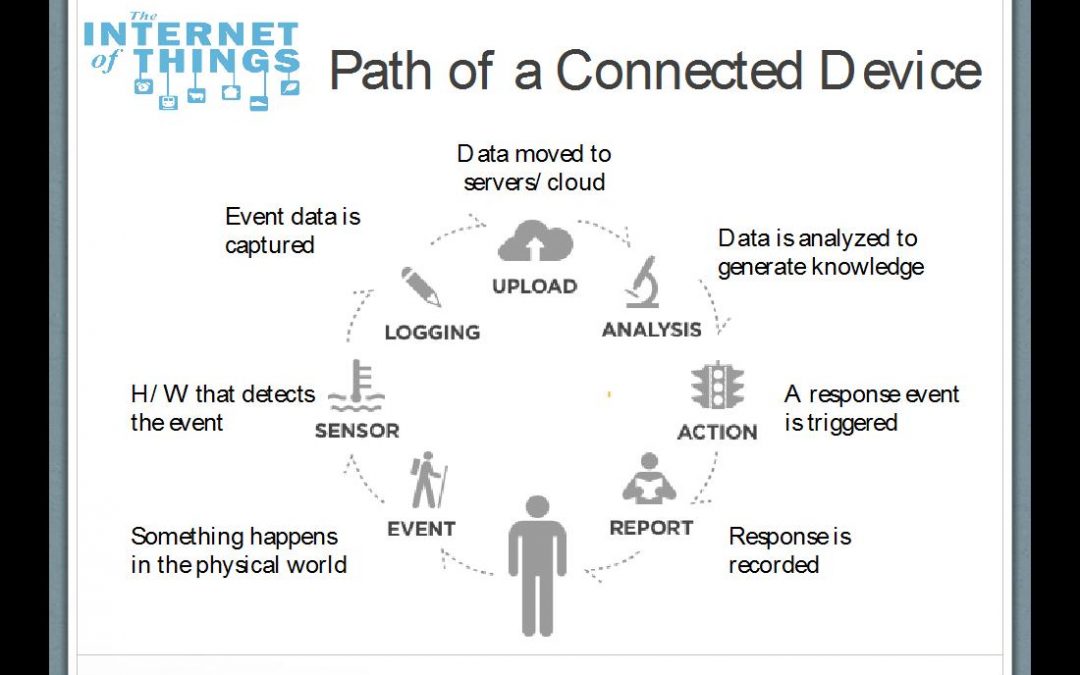
by Jennifer Hart Yim | Jun 26, 2014 | Blog, Internet of Things, Logistics, Manufacturing & Distribution, Marketing, Social Media, Strategy, Supply Chain

This article is part of a series of articles written by MBA students and graduates from the University of New Hampshire Peter T. Paul College of Business and Economics.
Supply Chain Management will use the Internet of Things to improve factory workflow, increase material tracking, and optimize distribution to maximize revenues.
“Clap on “(clap, clap), “Clap off” (clap, clap), “the Clapper”!!
When introduced in 1986, “The Clapper” light switch was considered a significant breakthrough in home automation. Today, with advances in communication, sensors, and internet-connected devices, you can change the temperature of your home, your lights, appliances, and security system all from your smartphone — from anywhere in the world. This is just one simple example in the growing “Internet of Things” technology. The potential is enormous, not just in home automation but in industrial applications like manufacturing and distribution.
The Internet of Things (IoT) is broadly defined as the merging of the physical and digital worlds. It’s a scenario in which people and/or objects can be uniquely identified with the ability to share information over a network without any actual conscious intervention. The data is automatically transferred, analyzed, and used to trigger an event. Figure 1 below demonstrates how one of these devices functions and interacts with the Internet and other devices.
Figure 1.
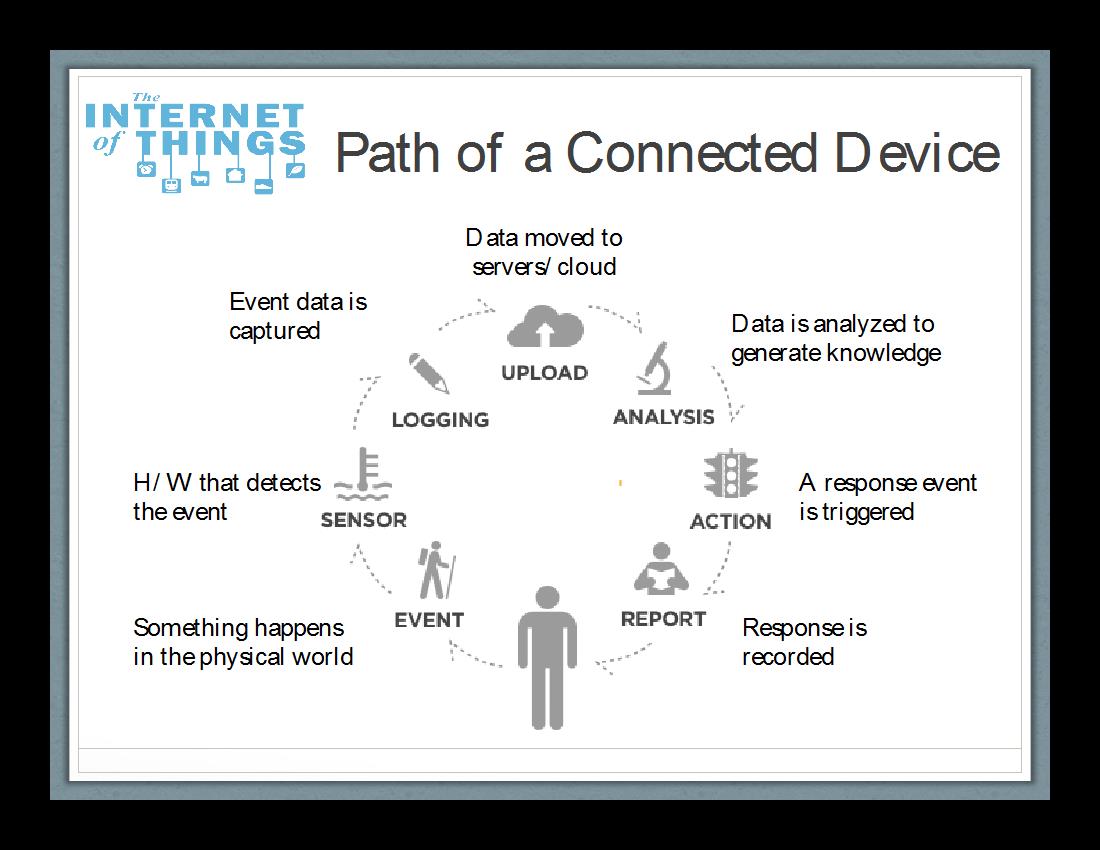
The IoT and Supply Chain Management
While many of us may be familiar with recent advancements in home automation, like the Nest thermostat, the real impacts of IoT will be in Supply Chain Management. Recent reports by Cisco, IDC and Gartner all claim that a significant increase in the number of devices making up the Internet of Things will have a profound impact on how future supply chains will operate. The 2011 Cisco report predicts there will be 50 billion connected devices globally by 2020, or about 6.5 devices for each person, up from only approximately 2.5 today (see figure 2). More active devices means more available data — to the point where they will be ubiquitous and transparent in our every day lives.
Figure 2.
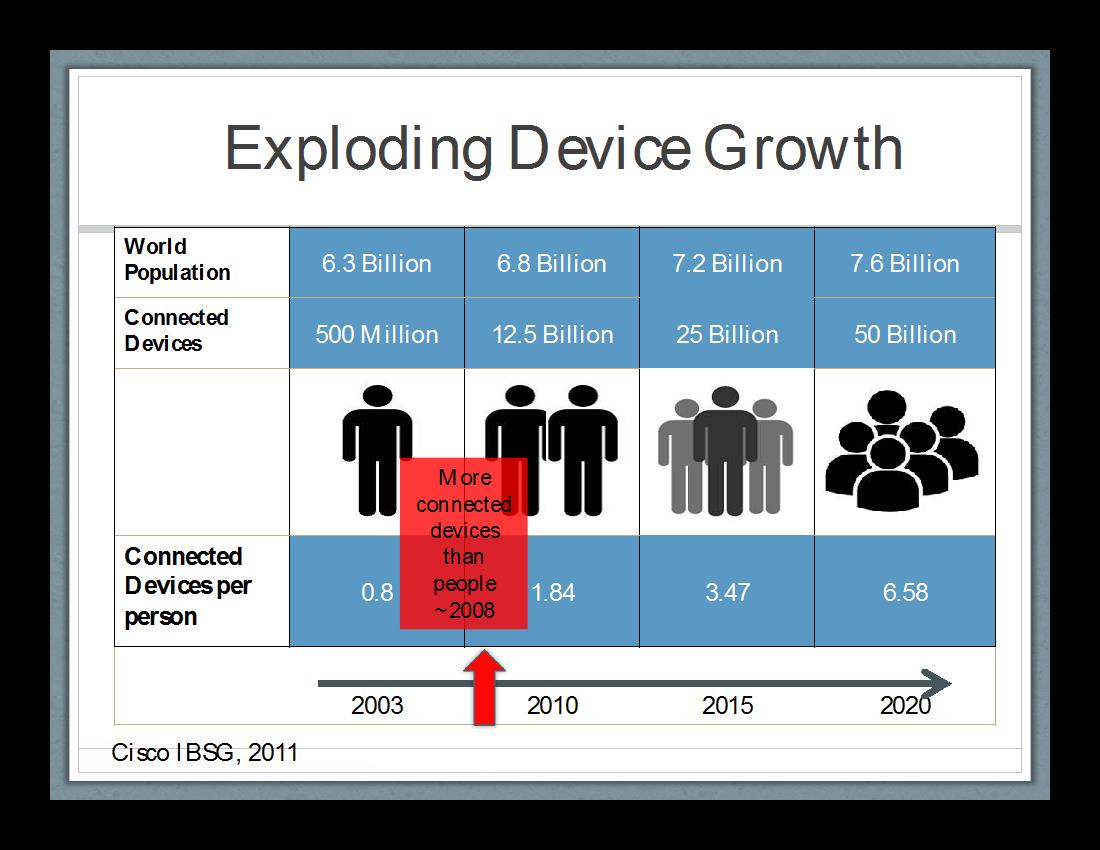
Impacts to supply chain will be broad and far-reaching, utilizing Big Data to gather and analyze information across the entire process.
Some IoT devices have been in place for some time, such as commercial telematics now used in trucking fleets to improve logistics efficiency. Other commercial type applications — like fabrics that use sensors within clothing and industrial fabrics to monitor human health or manufacturing processes — are just being developed now.
Mark Morely of GSX, a leading provider of monitoring and management solutions, recently discussed three key impacts he believed IoT would have on the Supply Chain industry: Pervasive Visibility, Proactive Replenishment, and Predictive Maintenance. This is a great way to explain the immediate benefits, so I will summarize Mark’s description and expand with some real-world examples.
Three key impacts the IoT will have on the supply chain industry
1) Pervasive Visibility
Mark describes this as the ability to track and monitor a shipment in real time using a combination of sensors (RFID), connected devices, and communication channels (3G/4G, GPS, internet). It provides the ability to have real-time transit status, including location, temperature, and diagnostics — far more information than legacy infomatics provided.
One great example I found is from a company called Purefresh, who are at the cutting edge of Supply Chain IoT technology. They offer not only real-time shipment condition tracking, but also the ability to model and develop transit routes to optimize freshness in perishable cargo — taking into account environmental elements, such as ozone, atmospheres, and temperature. They indicate that an estimated “30% to 50% (or 1.2-2 billion tons) of all food produced on the planet is lost before reaching a human stomach.” IoT advancements will not only better optimize transit flow but also better serve humanity.
2) Proactive Replenishment
It’s the capability to automatically recognize the need to order and restock a product on a “machine-to-machine” basis, reducing the need for human interaction. The most common example is that vending machines will know when it’s out of or low on a Snickers bars and immediately trigger an alert to reorder them, instead of waiting for a service person to check on the vending machine and reorder products manually. The result is less human intervention, quicker replenishment, better sales forecasting and ultimately increased revenues. Oh, and many more happy office workers who really need a mid-afternoon sugar rush!
Opportunities for this technology go far beyond the candy vending machine though. Industries with time critical inventories like hospitals and pharmacies can better maintain supplies by supplementing human inventory control with real time use tracking. A much less critical but more broadly used application comes from Coke’s Freestyle fountain soda machine. It’s about the same size as the existing vending machines but it can dispense 126 kinds of flavors, offering an almost infinite amount of combinations. It uses Radio Frequency ID (RFID) cartridges that store the concentrated syrups in the machine. The RFID chips detect how much of each syrup it has and what combinations are being used. When it detects that it needs supplies, it transmits the information to both Coca-Cola and the storeowner including what has been sold, a record of when sales occurred, troubleshooting information, and service data. As a result, soda sales and customer satisfaction increases, all with less effort by the storeowner.
3) Predictive Maintenance
This application is closer to the true machine-to-machine communications the IoT was intended for. From large-scale manufacturing to diagnostics on the family minivan, predictive maintenance utilizes sensors and connected devices to monitor and react to issues. This self-diagnosis capability can detect a potential issue before there’s a failure, order a replacement part, and even schedule maintenance to avoid costly downtime.
Not only does predictive maintenance help keep factories running longer and the family minivan from unexpectedly breaking down, it can improve efficiency throughout the whole supply chain. If equipment manufacturers constantly receive service data from factory equipment, they can better trend problems and focus on those issues for future products. Parts depots can better forecast inventories and determine consistent safety stock levels. IoT, in this example, is a true B2B (business to business) — automating the communication between businesses on every link of the chain.
In relation to home automation, predictive maintenance will become integrated into our everyday lives. Appliances will become smarter, more efficient, and easier to monitor. Internet-connected sensors will be embedded into everything from refrigerators to washers/dryers and HVAC systems. So much so that companies like GE are investing heavily into these technologies, in both commercial and industrial applications. These connected appliances will perform self-diagnosis, determine the most cost-efficient time to operate, and even automatically order maintenance parts like furnace filters when needed. Imagine getting an alert on your smartphone that your forced hot air furnace needs a new air filter, and it has already been ordered through your Amazon account. It just saved you effort in remembering to check the filter and ordering it — leading to a cleaner, longer-lasting, and more efficient furnace.
So, why isn’t IoT here yet?
It’s close but there are still hurdles to overcome. In recent years, advances in sensor technologies, 4G communications, and cloud computing has made achieving Internet of Things capabilities even more possible. But for companies in the Supply Chain to leverage these opportunities, they will need to expand investment into cloud-based platforms that can support scalable devices and data-analysis services.
Critical to IoT’s success will be the necessary “middleware” software communication protocols to link all these devices. Companies like ProSyst and open-source SW projects like OPENIoT are pioneering these capabilities. But even with this progress, agreements on industry standards will be key to long-term platform success.
Having a common IoT protocol will be necessary to link the physical and digital worlds on a consistent and economical basis. Understanding the need for standards and common architectures, Intel has led the way by recently creating the not-for-profit Industrial Internet Consortium (IIC) with other vested companies like AT&T, Cisco, GE, and IBM. The connected Supply “Chain” will become exponentially longer once these common standards are in place.
The Internet of Things trend is quickly approaching and will impact the way we live and work through increased productivity and efficiency. Supply Chain Management will continue utilizing these advanced technologies to improve factory workflow, increase material tracking, and optimize distribution to maximize revenues.
In 1986, I recall how innovative I thought the Clapper was — I couldn’t have imagined how connected we would become only 28 years later. And the next 28 will be sure to amaze.
Steve Mondazzi is a Principal Master Planner in the Defense Contracting industry. After 20 years’ experience in project management and schedule development, he decided to further his education by recently earning a Masters in Technology Management at the University of New Hampshire. He’s a certified PMI Project Management Professional, an entrepreneur, and an avid lover of all things technology. He currently resides in Massachusetts with his wife, two teenagers, and an excessive collection of headphones. Steve can be contacted via his Twitter account @schedulepro or through LinkedIn.
Related posts:
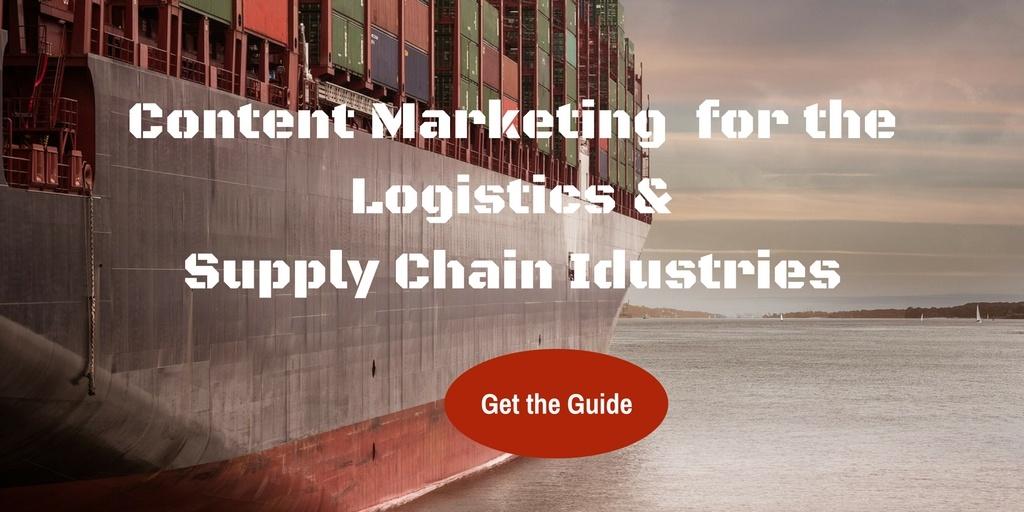

by Jennifer Hart Yim | Jun 19, 2014 | Blog, Logistics, Manufacturing & Distribution, Strategy, Supply Chain

Entrants to the market need to understand the barriers to entry and problems with management and transparency within the pet food industry supply chain.
This article is part of a series of articles written by MBA students and graduates from the University of New Hampshire Peter T. Paul College of Business and Economics.
The pet food industry is a market that boasts $21.57 billion dollars in sales in the United States (2013). With 95.6 million cats and 83.3 million dogs owned in the United States, it is no wonder that there is such a large market for the food that the self-proclaimed “pet parents” feed them. However, it isn’t all good news for aspiring entrants, as they must first understand the supply chain that dictates this growing industry.
To manufacture, or not to manufacture
When a pet food company chooses to produce a product, they essentially have three options: 1) manufacture it themselves, or choose a co-packer who will either 2) use a private label or 3) manufacture the food to the specifications of the brand.
A contract packer (co-packer), otherwise known as a contract manufacturer, is a company that manufactures and packages foods for their clients. The manufacturer works under a contract with the hiring company to manufacture the pet food as though the hiring company was doing it themselves.
Co-packers can manufacture several different brands and for several companies at once. An example of a co-packer would be C.J. Foods, Inc. with manufacturing plants in Bern, Kansas, and The Pawnee City, Nebraska. According to C.J. Foods Inc., the company produces over 300 varieties of animal foods, including dog, cat, reptile, and exotic bird.
Companies typically outsource to another entity for production due to cost savings, rather than building their own plant. Additionally, they can focus on their own core competence, whether it is marketing, sales, etc. The manufacture’s core competency is production, and they have the experience and knowledge to produce the pet foods already. However, there can be many challenges associated with the management of pet food supply chains and co-packers in particular.
The challenges with co-packers
As the pet food market grows and becomes more complex, the sourcing of ingredients becomes more complicated.
Foreign suppliers source products from numerous small farms, and identities become lost and commingled. Unfortunately, brands are relying on these suppliers to meet food-safety criteria.
Additionally, these brands typically rely on audits of suppliers by private third-party companies that carry no guarantee. An example of this would be Kellogg and Peanut Corporation of America (PCA). Kellogg had PCA audited by AIB international, and PCA passed with a superior rating. However after the recall (explained in detail below), the FDA found leaks and rodent infestations within the plant.
Pet food industry product recalls
There have been two major recalls within the pet food industry in recent years.
One, the largest in history, was the ChemNutra recall in 2007. Two Chinese export firms sold wheat gluten bags tainted with melamine to Las Vegas-based ChemNutra, “the Chinese ingredient specialist importer.” ChemNutra then sold the tainted wheat gluten to pet food makers under false certificates of analysis. As a result, 5,300 pet foods were recalled, and thousands of cats and dogs were injured/killed. Owners of both the Chinese companies and ChemNutra pleaded guilty to various misdemeanors involving the mis-branding of food and conspiracy to commit wire fraud.
The second recall involves a 2009 salmonella outbreak in the Peanut Corporation of America’s plant in Blakely, Georgia. PCA knowingly shipped salmonella-tainted products across the country to many manufacturers, including those in the pet food industry. Along with the shipments, they sent certificates of analysis that indicated the product contained no salmonella, but they had yet to receive the test results (which were positive). This resulted in 3,200 pet food products being recalled, 8 deaths, and 500 illnesses. A 76-count indictment charged four former officials at PCA with numerous infractions relating to salmonella-tainted peanuts and peanut products.
These two examples are the horrific results from a lack of control over the supply chain within the manufacturing of pet foods. The consequences of these recalls, first and foremost, can cause the injury and death of both pets and people. Beyond that, there is implicit lost brand trust, consumer demand decrease, headaches for retailers/wholesalers, and severe cost increases for the company.
Solution: Improving supply chain management
Given the information above, it is essential that companies proactively work to avoid recalls through better management of the supply chain.
Co-packers become problematic when an ingredient or plant is infected because that trickles down to the many different brands and companies for whom they manufacture. That is not to say that pet food companies should never use a co-packer, especially because the cost-saving benefits can be so great. Pet food companies, however, should do their research prior to choosing a co-packer.
If you are using a private label, know where the co-packer is sourcing its ingredients. If you are not using a private label, you need to ensure you know the suppliers with whom the co-packer is working. The same rule applies if your pet food company has its own manufacturing plant, as well.
Secondly, pet food manufacturers can supplement third-party audits of co-packers’ plants with their own inspection and testing of ingredients and plant surfaces.
As a consumer purchasing these foods off the shelf, attempt to do your research, too. Although you may not be able to see exactly where products are coming from due to confidentiality of competitive sourcing, you can choose brands that have a commitment to transparency and educating the consumer on where their ingredients are sourced from. An example of this would be Natura Pet Products, which launched its “See Beyond The Bag” campaign. This part of their interactive website allows consumers to click on any product and view where in the world any specific ingredient in the product is being sourced from. Additionally, consumers can educate themselves on how Natura ensures a quality manufacturing process.
In conclusion, pet food manufacturing can be a difficult industry if a company is not well versed in the associated challenges. If a tight reign is held over the supply chain and quality manufacturing follows, the pet food industry is a growing market with a bright outlook for companies vying to do business within it.
Mikayla Cadoret recently completed her MBA at the University of New Hampshire – Paul College of Business and Economics. She is an experienced sales representative and is interested in pursuing a career in marketing or supply chain management. She can be reached at [email protected].











